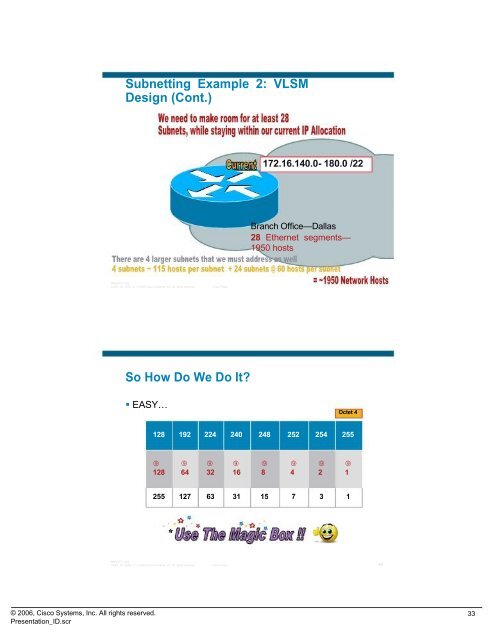Subnetting Example 2: VLSM Design - Cisco Learning Home
Subnetting Example 2: VLSM Design - Cisco Learning Home
Subnetting Example 2: VLSM Design - Cisco Learning Home
Create successful ePaper yourself
Turn your PDF publications into a flip-book with our unique Google optimized e-Paper software.
<strong>Subnetting</strong> <strong>Example</strong> 2: <strong>VLSM</strong><br />
<strong>Design</strong> (Cont.)<br />
BRKCRT-1102<br />
14364_04_2008_c1 © 2008 <strong>Cisco</strong> Systems, Inc. All rights reserved. <strong>Cisco</strong> Public<br />
So How Do We Do It?<br />
EASY…<br />
128 192 224 240<br />
172.16.140.0- 180.0 /22<br />
Branch Office—Dallas<br />
28 Ethernet segments—<br />
1950 hosts<br />
Octet 4<br />
248 252 254 255<br />
<br />
128 64 32 16 8 4 2 1<br />
255 127 63 31 15 7 3 1<br />
BRKCRT-1102<br />
14364_04_2008_c1 © 2008 <strong>Cisco</strong> Systems, Inc. All rights reserved. <strong>Cisco</strong> Public 66<br />
© 2006, <strong>Cisco</strong> Systems, Inc. All rights reserved. 33<br />
Presentation_ID.scr<br />
65
Computing the Mask for the<br />
Large Subnets<br />
~114 network device IP addresses required<br />
Octet 4<br />
128 192 224 240 248 252 254 255<br />
<br />
128 64 32 16 8 4 2 1<br />
255 127 63 31 15 7 3 1<br />
127 is bigger than 114,<br />
63 is not<br />
BRKCRT-1102<br />
14364_04_2008_c1 © 2008 <strong>Cisco</strong> Systems, Inc. All rights reserved. <strong>Cisco</strong> Public<br />
Computing the Mask for the<br />
Small Subnets<br />
60 network device IP addresses required<br />
128 192 224 240 248 252<br />
Octet 4<br />
254 255<br />
<br />
128 64 32 16 8 4 2 1<br />
255 127 63 31 15 7 3 1<br />
63 is bigger than 60,<br />
31 is not<br />
BRKCRT-1102<br />
14364_04_2008_c1 © 2008 <strong>Cisco</strong> Systems, Inc. All rights reserved. <strong>Cisco</strong> Public 68<br />
© 2006, <strong>Cisco</strong> Systems, Inc. All rights reserved. 34<br />
Presentation_ID.scr<br />
67
Address Allocation for Dallas<br />
Start with the Large Subnets (128 block)<br />
Beginning with 172.16.140.0 as base address<br />
Subnet ID Host Range Broadcast Address<br />
1 172.16.140.0 172.16.140.1 - .140.126 172.16.140.127<br />
2 172.16.140.128 172.16.140.129 - .140.254 172.16.140.255<br />
3 172.16.141.0 172.16.141.1 - .140.126 172.16.141.127<br />
4 172.16.141.128 172.16.141.129 - .141.254 172.16.141.255<br />
BRKCRT-1102<br />
14364_04_2008_c1 © 2008 <strong>Cisco</strong> Systems, Inc. All rights reserved. <strong>Cisco</strong> Public 69<br />
Address Allocation for Dallas (Cont.)<br />
Now create the ranges for the small subnets (64 block)<br />
Beginning with 172.16.142.0 as base address (where we left off)<br />
Subnet ID Host Range Broadcast Address<br />
5 172.16.142.0 172.16.142.1 - .142.62 172.16.142.63<br />
6 172.16.142.64 172.16.142.65 - .142.126 172.16.142.127<br />
7 172.16.142.128 172.16.142.129 - .142.190 172.16.142.191<br />
8 172.16.142.192 172.16.142.193 - .142.254 172.16.142.255<br />
9 172.16.143.0 172.16.143.1 - .143.62 172.16.143.63<br />
10 172.16.143.64 172.16.143.65 - .143.126 172.16.143.127<br />
11 172.16.143.128 172.16.143.129 - .143.190 172.16.143.191<br />
12 172.16.143.192 172.16.143.193 - .143.254 172.16.143.255<br />
… …and so on… …12 more subnets are built… …and you end up with…<br />
24 172.16.147.192 172.16.147.193 - .147.254 172.16.147.255<br />
BRKCRT-1102<br />
14364_04_2008_c1 © 2008 <strong>Cisco</strong> Systems, Inc. All rights reserved. <strong>Cisco</strong> Public 70<br />
© 2006, <strong>Cisco</strong> Systems, Inc. All rights reserved. 35<br />
Presentation_ID.scr

















